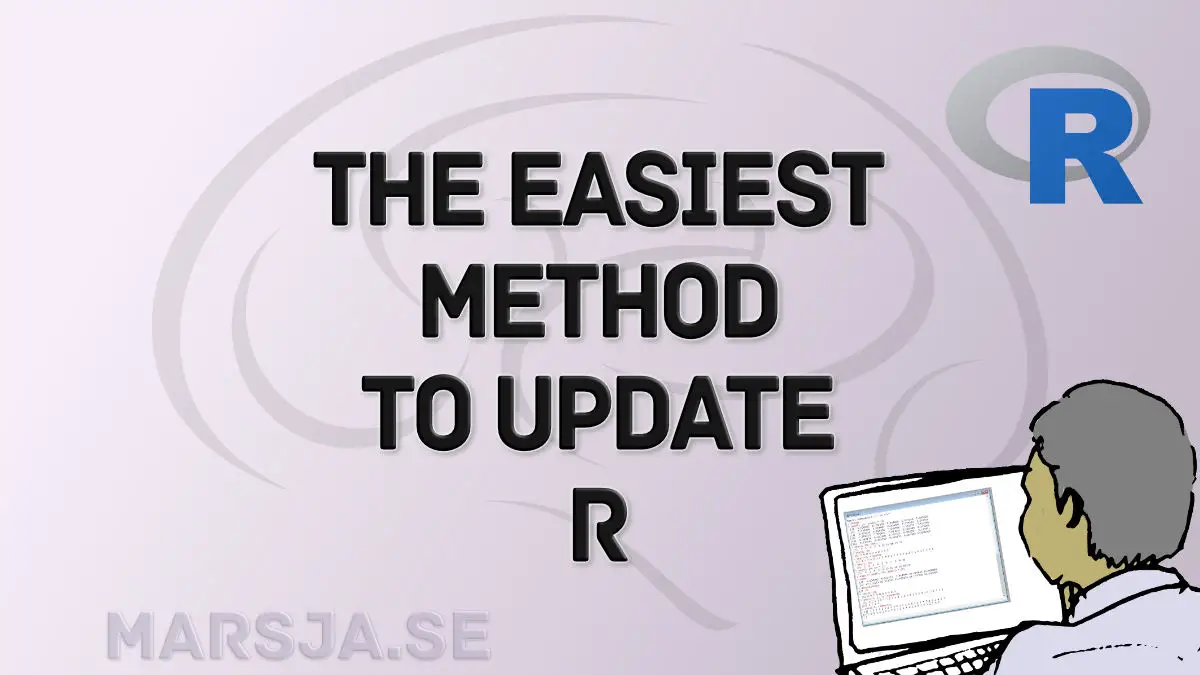Keeping your software tools up-to-date is essential for a seamless and efficient workflow, and the R programming language is no exception. In this blog post, we will explore the importance of updating R, discuss the circumstances that may necessitate an update, address the possibility of updating R within RStudio, and explore different methods for upgrading R. So, if you want to stay ahead with the latest features, bug fixes, and improvements, read on to discover how to update R in your RStudio environment.
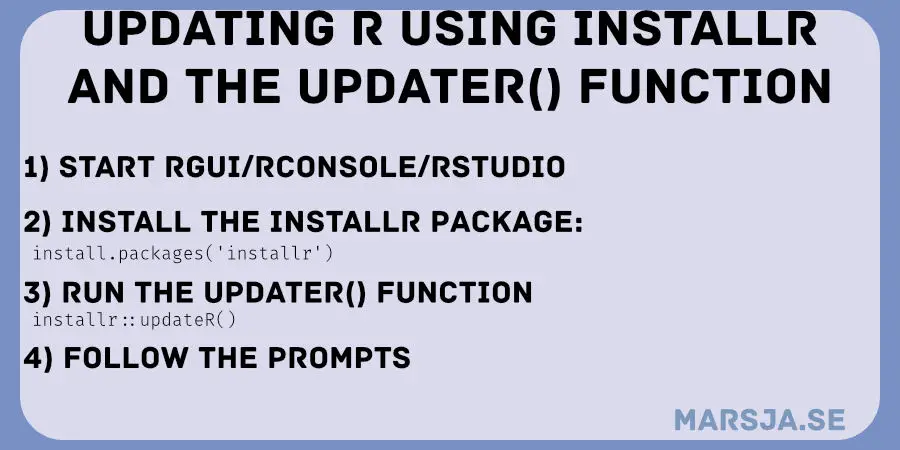
Table of Contents
- How to Check R Version in RStudio
- Why do we need to update R?
- When may we need to update R?
- Can we update R in RStudio?
- What are the different methods for upgrading R?
- Outline
- How to Update R in Windows: Three Methods
- Upgrade R from RStudio
- Which Method for Updating R?
- Conclusion: Update R
- Other Resources
How to Check R Version in RStudio
To check which R version you are currently running, you can open up the console (or start RGui) and follow these steps:
- In RStudio, you will find the R Console in the bottom left panel. Click on it to open the console.
- In the console, type
versionand press Enter. This command will display detailed information about your R installation, including the version number. - After running the version command, the R version information will be displayed in the console output.
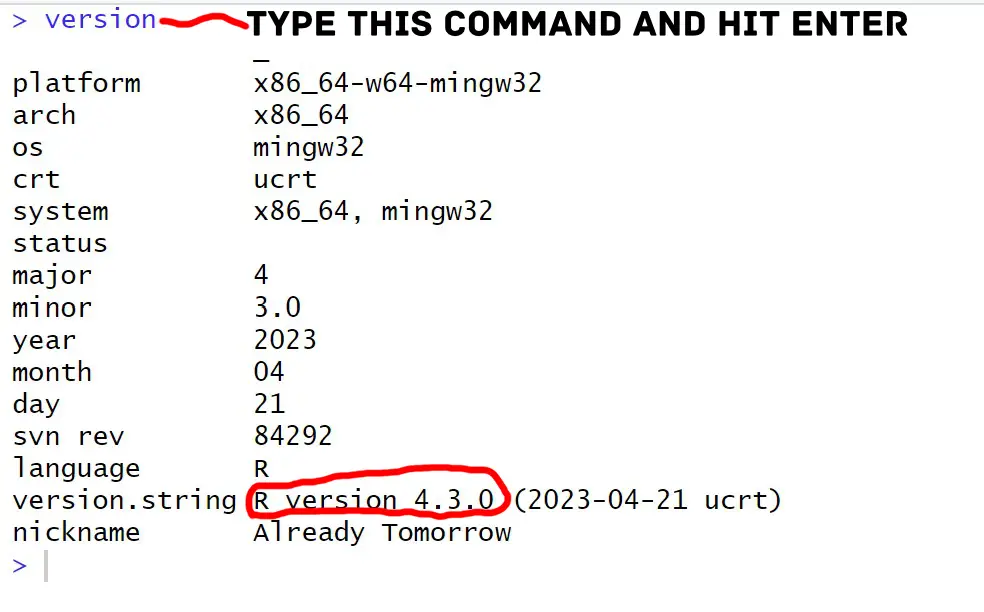
Note that you can also see which R version you are running top left above the console:
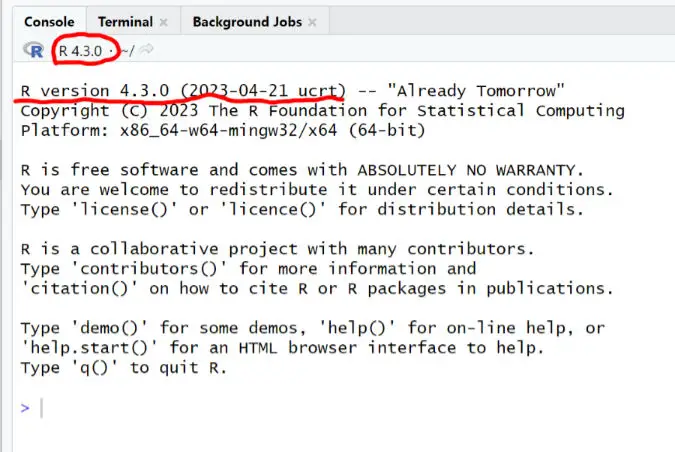
Now you know how to check the R version in RStudio. In the next section, you will learn why we may want to update R to the latest version.
Why do we need to update R?
Staying current with R updates brings many benefits that may enhance your programming experience. Here are three key reasons why updating R is important:
- Performance and Stability: Each R update incorporates enhancements and bug fixes, leading to a more stable and reliable environment for data analysis and statistical modeling tasks.
- Security: Updates can include security patches that protect your R environment from potential vulnerabilities, ensuring the confidentiality and integrity of your data.
- New Features and Functionality: Regular updates introduce new features, packages, and functionalities that expand the capabilities of R, allowing you to use the latest advancements in data science and statistical analysis.
When may we need to update R?
While it is generally beneficial to keep R up-to-date, there are specific scenarios where updating becomes particularly important:
- Package Dependencies: Some R packages require specific R versions to function correctly. When using packages that have updated their dependencies, you may need to update R to ensure compatibility and take advantage of the latest package features.
- Bug Fixes: Updates often address known bugs, resolving issues affecting your current workflow. You can benefit from the bug fixes and improvements introduced in the latest version by updating R.
- New Functionality: If you need a specific feature or functionality only available in a newer version of R, updating becomes necessary to access those capabilities.
Can we update R in RStudio?
Yes, you can update R directly within your RStudio environment. RStudio provides a convenient interface for managing your R installations and simplifies updating to the latest R version. Following a few straightforward steps, you can ensure your, e.g., RStudio runs on the most recent version of R.
What are the different methods for upgrading R?
Apart from updating R within RStudio, there are alternative methods available for upgrading R:
- Manual Installation: Visit the official R website and download your operating system’s latest version of R. Follow the installation instructions to upgrade your R installation.
- Package Managers: Some package managers, such as Homebrew for macOS and Chocolatey for Windows, offer the option to install and update R. Using package managers simplifies the process by handling dependencies and updates automatically.
- Command Line: If you prefer working with the command line, you can use specific commands to update R. For example, in R, you can use the
installrpackage and itsupdateR()function to upgrade R from within the R console.
Having understood the significance of updating R and the circumstances that call for an update, let us now look at the outline of this blog post.
Outline
The outline of the blog post is as follows. First, we start by addressing how to check the R version in RStudio, ensuring you have the necessary information to proceed. Next, we cover the importance of updating R, discussing its benefits to your data analysis and statistical modeling workflows. We explore the situations that may prompt the need for an R update, ensuring you understand when it is necessary to stay up-to-date.
Moving on, we address whether R can be updated within RStudio, providing clarity on the capability of this popular IDE. We then jump directly into the different methods available for upgrading R, offering you a range of options to suit your preferences and requirements.
In the subsequent sections, we provide a detailed guide on updating R in Windows using three methods. Firstly, we explain the process of manually updating R, ensuring you have complete control over the installation. Secondly, we demonstrate how to update R using the convenient updateR() function within the RStudio environment, streamlining the update process. Lastly, we explore the usage of the Chocolatey Package Manager as an alternative method for updating R in Windows.
How to Update R in Windows: Three Methods
Updating R in Windows is a straightforward process that can be achieved through various methods. In the following subsections, we will explore three different approaches. First, we will describe how to download and install the latest version of R manually. Then, we will discuss the convenience of using the updateR() function within the R console. Finally, we will explore utilizing package managers to update R in your Windows environment seamlessly.
1: Manually Updating R
Here are the steps to manually update R in Windows:
- Visit the official R website: Go to the official website of R (https://www.r-project.org/).
- Choose a CRAN mirror: On the R homepage, navigate to the “Download” section and select a CRAN mirror that is geographically close to your location. CRAN mirrors are servers that host R and its packages.
- Select the base distribution: Under the selected CRAN mirror, click on the link corresponding to your Windows operating system. Choose the “base” distribution, which includes the essential components of R.
- Download the installer: On the base distribution page, click the link to download the installer file for the latest version of R. The installer file usually has a name like “R-x.x.x-win.exe,” where “x.x.x” represents the version number.
- Run the installer: Locate the downloaded installer file on your computer and double-click on it to run the installation process.
- Choose installation options: Follow the prompts provided by the installer to select the desired installation options. You can typically accept the default settings unless you have specific preferences.
- Install R: Proceed with the installation by clicking the appropriate buttons. The installer will extract the necessary files and install R on your Windows system.
- Verify the installation: Once the installation is complete, you can verify the updated R version by launching RStudio or opening the R console. In the console, type
versionand press Enter. The displayed version should match the latest version you installed.
2: Updating R using the updateR() function
Here is how to update R using the updateR() function:
- Launch RGui: Open RGui to access the R console, where you will run the update command.
- Load the installr package: If you have not already, install and load the installr package using
install.packages("installr")andlibrary(installr). - Run the updateR() function: In the R console, type
updateR()and press Enter to initiate the update process. - Follow the prompts: The
updateR()function will guide you through the update process, displaying available updates and asking for confirmation. - Select update options: Depending on your preferences, you may be prompted to choose update options such as updating only R or including packages.
- Update process: The function will handle the necessary steps, including downloading and installing the latest R version.
- Verify the update: After the update process completes, you can verify the updated R version by typing
versionin the R console and pressing Enter.
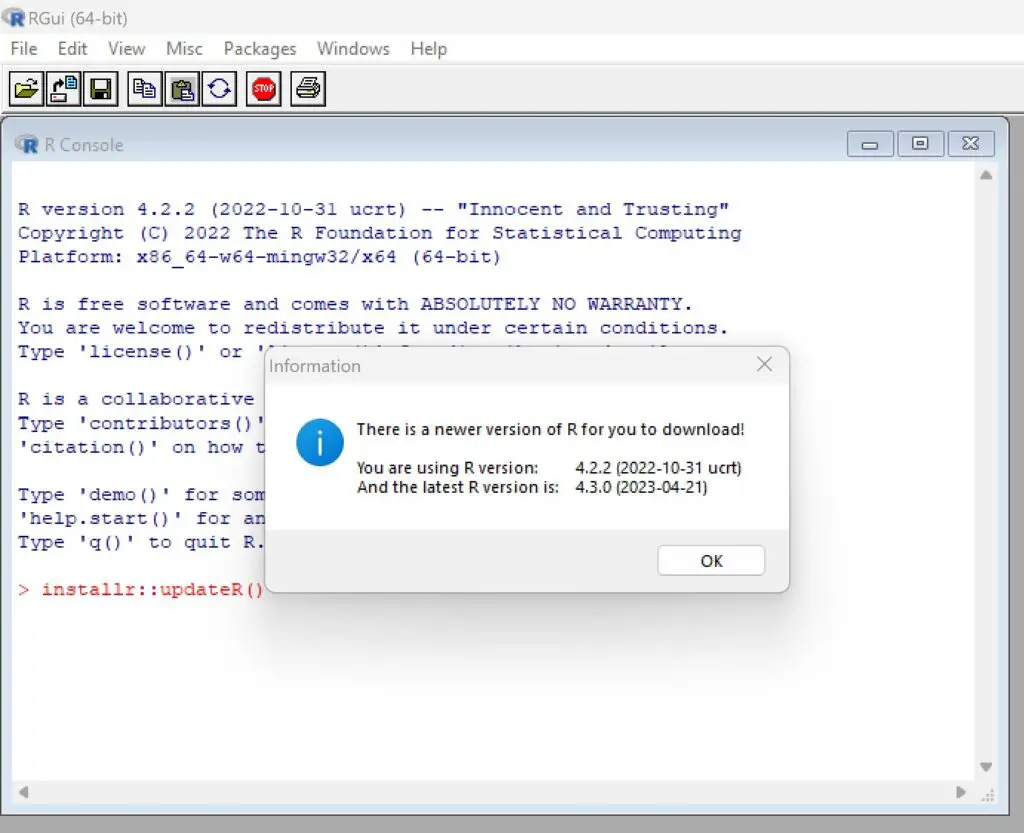
Note that this method is the same as upgrading R from within RStudio (we open up RStudio instead of RGui).
3: Using Chocolatey Package Manager
Updating R using Chocolatey Package Manager:
- Install Chocolatey: If you don’t have Chocolatey installed, visit the Chocolatey website (https://chocolatey.org/) and follow the installation instructions for Windows.
- Open Command Prompt or PowerShell: Launch Command Prompt or PowerShell on your Windows system.
- Check Chocolatey installation: In the Command Prompt or PowerShell, type
choco -vand press Enter to verify that Chocolatey is installed correctly. - Update Chocolatey packages: To ensure you have the latest Chocolatey packages, type
choco upgrade chocolateyand press Enter. Follow any prompts if necessary. - Update R: In the Command Prompt or PowerShell, type
choco upgrade rand press Enter. Chocolatey will handle the process of updating R to the latest version. - Verify the update: After completing the update, you can verify the updated R version by launching RStudio or opening the R console. Type
versionand press Enter. The displayed version should match the latest version available.
Note for reproducibility: you may want to change the R version in RStudio and run an older version you have installed on your computer.
Upgrade R from RStudio
To upgrade R itself from within RStudio, you can make use of the installr package, which provides a convenient way to install or upgrade R. Follow these steps:
- Install the installr package: If you haven’t installed the
installrpackage yet, open RStudio and run the commandinstall.packages("installr")to install it. - Load the installr package: Once the package is installed, load it into your R session by running
library(installr). - Run the updateR() function: In the R console, type
updateR()and press Enter. This function will check for the latest version of R and guide you through the upgrade process. - Follow the prompts: The
updateR()function will prompt you with instructions, including asking for confirmation before upgrading. Follow the prompts accordingly. - Upgrading R: The function will handle the necessary steps to upgrade R, including downloading and installing the latest version.
- Verify the upgrade: After the upgrade process completes, you can verify the updated R version by typing
R.version$versionin the R console and pressing Enter.
Note that using the installr package to upgrade R from within RStudio follows the same method as using it from other R environments like RGui (as in a previous section).
By using the installr package within RStudio, you can conveniently upgrade R to the latest version without downloading and installing it manually. This lets you keep your RStudio environment up-to-date and benefit from R’s latest improvements and features.
Which Method for Updating R?
When it comes to upgrading R, the easiest method is using the installr package and its updateR() function. This approach simplifies the process by automating the update steps and providing clear prompts. With just a few commands in the R console, you can effortlessly initiate the upgrade process, making it ideal for users who prefer a straightforward and user-friendly approach.
Following the installr package, using the Chocolatey package manager also offers a relatively easy way to update R. However, it does come with some drawbacks. Before utilizing Chocolatey, you need to install the package manager itself, which adds an extra step to the process. Additionally, using Chocolatey requires knowledge of running PowerShell commands, which might be unfamiliar to some users. Despite these minor challenges, updating R once Chocolatey is set up becomes a relatively streamlined task.
On the other hand, manually installing a new version of R is the most cumbersome method for upgrading. This process involves downloading the latest R installer, running the installation package, and ensuring that all dependencies are properly managed. It requires more manual intervention and is prone to errors or compatibility issues. Consequently, it is generally considered the least convenient option for users seeking a quick and hassle-free upgrade experience.
Considering the ease of use, the installr package with its updateR() function stands out as the simplest and most user-friendly method for upgrading R. However, depending on individual preferences and technical proficiency, users may opt for the Chocolatey package manager or manual installation when needed.
Conclusion: Update R
In the blog post, we have learned about the importance of keeping R up-to-date and explored various methods to update it within RStudio. We discovered how to check the R version, identified situations requiring an R update, and clarified that R could be updated within the RStudio environment. We explored three different approaches for upgrading R in Windows: manual installation, utilizing the updateR() function, and leveraging the Chocolatey Package Manager.
By following the outlined steps and utilizing the provided methods, you can easily ensure that your R installation remains current, benefiting from the latest features, improvements, and bug fixes. Keeping R up-to-date is crucial for staying at the forefront of data analysis and statistical modeling.
I encourage you to share this blog post with others who may find it useful. If you have found value in this content, linking back to it or mentioning it in your own articles, blog posts, or social media posts can help others discover these valuable insights.
Remember, regularly updating R is a small investment that can yield significant benefits in terms of efficiency, compatibility, and access to the latest advancements in the R ecosystem.
Other Resources
Here are some other R resources you might find helpful:
- How to use %in% in R: 8 Example Uses of the Operator
- Countif function in R with Base and dplyr
- Mastering SST & SSE in R: A Complete Guide for Analysts
- Select Columns in R by Name, Index, Letters, & Certain Words with dplyr
- Test for Normality in R: Three Different Methods & Interpretation
- Report Correlation in APA Style using R: Text & Tables
